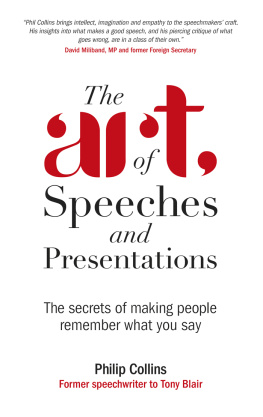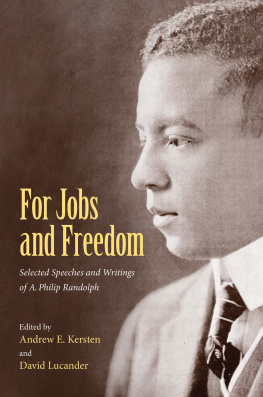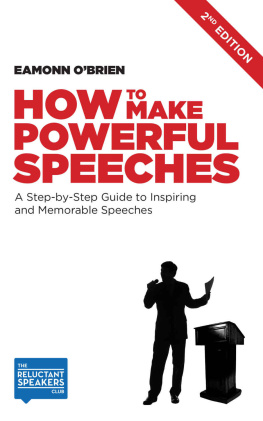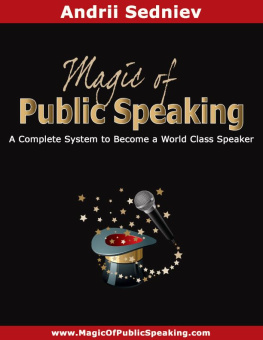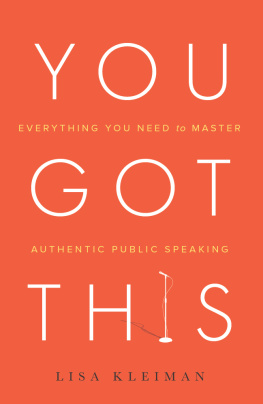
Philip Collins is a columnist on The Times , chair of the Board of Trustees of the think-tank Demos and chief executive of High Windows Ltd, a speech-writing company. He was, until 2007, the Chief Speech Writer to the Prime Minister, Tony Blair. He has also worked as an investment banker and ran the Social Market Foundation, a political think tank. Since leaving Downing Street, he has written speeches for many chief executives in the corporate and voluntary sectors and for many senior government ministers. He writes a regular column analyzing important speeches for The Times .
This edition first published 2012
2012 Philip Collins
Registered office
John Wiley & Sons Ltd, The Atrium, Southern Gate, Chichester, West Sussex, PO19 8SQ , UK
For details of our global editorial offices, for customer services and for information about how to apply for permission to reuse the copyright material in this book please see our website at www.wiley.com.
The right of the author to be identified as the author of this work has been asserted in accordance with the Copyright, Designs and Patents Act 1988.
All rights reserved. No part of this publication may be reproduced, stored in a retrieval system, or transmitted, in any form or by any means, electronic, mechanical, photocopying, recording or otherwise, except as permitted by the UK Copyright, Designs and Patents Act 1988, without the prior permission of the publisher.
Wiley publishes in a variety of print and electronic formats and by print-on-demand. Some material included with standard print versions of this book may not be included in e-books or in print-on-demand. If this book refers to media such as a CD or DVD that is not included in the version you purchased, you may download this material at http://booksupport.wiley.com. For more information about Wiley products, visit www.wiley.com.
Designations used by companies to distinguish their products are often claimed as trademarks. All brand names and product names used in this book are trade names, service marks, trademarks or registered trademarks of their respective owners. The publisher is not associated with any product or vendor mentioned in this book. This publication is designed to provide accurate and authoritative information in regard to the subject matter covered. It is sold on the understanding that the publisher is not engaged in rendering professional services. If professional advice or other expert assistance is required, the services of a competent professional should be sought.
Library of Congress Cataloging-in-Publication Data
Collins, Philip, 1967
The art of speeches and presentations : the secrets of making people remember what you say / Philip Collins.
p. cm.
Includes bibliographical references and index.
ISBN 978-0-470-71184-2 (pbk. : alk. paper)
1. Public speaking. I. Title.
PN4129.15.C63 2012 2012004083
808.5'1dc23
A catalogue record for this book is available from the British Library.
ISBN 978-0-470-71184-2 (paperback) ISBN 978-0-470-71194-1 (ebk)
ISBN 978-0-470-71195-8 (ebk) ISBN 978-0-470-71193-4 (ebk)
To Hari and Mani, who are already teaching me about the art of argument
ACKNOWLEDGEMENTS
My professional thanks are due to three sets of people. First, my colleagues in Downing Street where I had the privilege of being able to enact everything I had learnt about writing a speech for the Prime Minister, Tony Blair.
Second, great thanks are due to The Times , whose generosity as an employer has allowed me the time off my duties there to write this book. I also owe a debt of thanks to The Times for granting me the space to analyse prominent speeches in its pages. Its a privilege to do so and the interest that these pieces have generated shows that rhetoric continues to fascinate people.
Third, to Brendan Barnes and the team at Speakers for Business who have helped to put together the speech-writing symposium at which I have tested the ideas contained in this book. My thanks are due to the people who came to those classes, for their stimulating thoughts and responses. For research assistance, my great thanks to Claudia Wood.
My personal debt of gratitude is much greater. Suffice to say that it is owed to an extended family but most of all to Geeta, Hari and Mani.
INTRODUCTION:
ATTENTION TO DETAIL
Speeches still matter, even in a technological age. The act of persuasion is ubiquitous in professional life and very many people need to master it. The act of making a speech is a medium that has remained essentially unchanged through the ages. The anthologies of great speeches are a reminder of the continuing power of well-arranged words but they are not necessarily the best guide to the task that you confront. A speech becomes memorable by virtue of the grandeur of the occasion it describes and most people are performing at a less exalted level. That does not mean that we cannot still write and speak well, or that there are not certain characteristics that all successful acts of communication have in common. This book will introduce the central argument that you need to understand your central argument. That is the most important precept of all good writing. This book will help you to master the basics of the craft with reference to the following mnemonic: D: effective Delivery; E: setting Expectations; T: the central argument, known as the Topic; A: understanding the Audience; I: making the speech Individual to you; and L: minding the Language that you deploy. Pay attention to detail. The precise details to which you must pay attention are the subject of this book.
Strange Isolation
A man steps forward out of the dark, alone, trailed by a spotlight. He walks slowly towards the podium which is the only thing that decorates the otherwise naked stage. He is being watched, not just by the two thousand people in the auditorium, all of whom are gripped by excitement, but by millions more watching as the event is broadcast live on television.
He walks into a strange isolation, for he knows, as does his audience, that he is about to beg their undivided attention for at least 25 minutes, probably more. There is no other setting in which we permit anyone to speak, uninterrupted, for so long. Yet this is precisely the exchange that we, as audience members, have licensed by our presence in the auditorium.
Some part of the audience is inquisitive, hoping to learn something; some part is sceptical, reluctant to be persuaded; and some part is eager, hoping to be inspired. Then there are audience members who are already bored, hoping, but not expecting, merely to hear something that retains their attention. Interest groups or rival firms or jealous colleagues are all paying particular mind, hopeful that the event will yield some advantage to their cause, even if that means you falling flat on your face, which will at least be amusing.
Soon enough, either simultaneous with delivery or very soon afterwards, the address will be enmeshed in a web of different technologies. If it is a major speech, it will be cut up and analysed for the news bulletins on television. It will be written up selectively for the newspapers the following morning. There may be a sketch of the speech, in which the writer picks out the one aspect that has gone wrong or is easily lampooned. Although the days in which speeches were published verbatim, without commentary, have gone for good, the speech may even be analysed in some depth with the best and worst passages highlighted and scrutinized.
Even if the occasion is not one that warrants the attention of the nation, it will rapidly be found in other contexts. The days when the speech existed solely as a transaction between the speaker and those in the audience are largely past. A transcript of the speech will probably be made available on an intranet, where the occasion will no doubt be broadcast. If it is not broadcast in real time, a recording of the occasion, certainly aural and probably visual, will be loaded onto the website later to the rest of the company sitting at their desks. Many speeches are multi-media events at the moment they occur. A transcript of the text may be circulated to members of an extensive corporate email distribution list.
Next page
